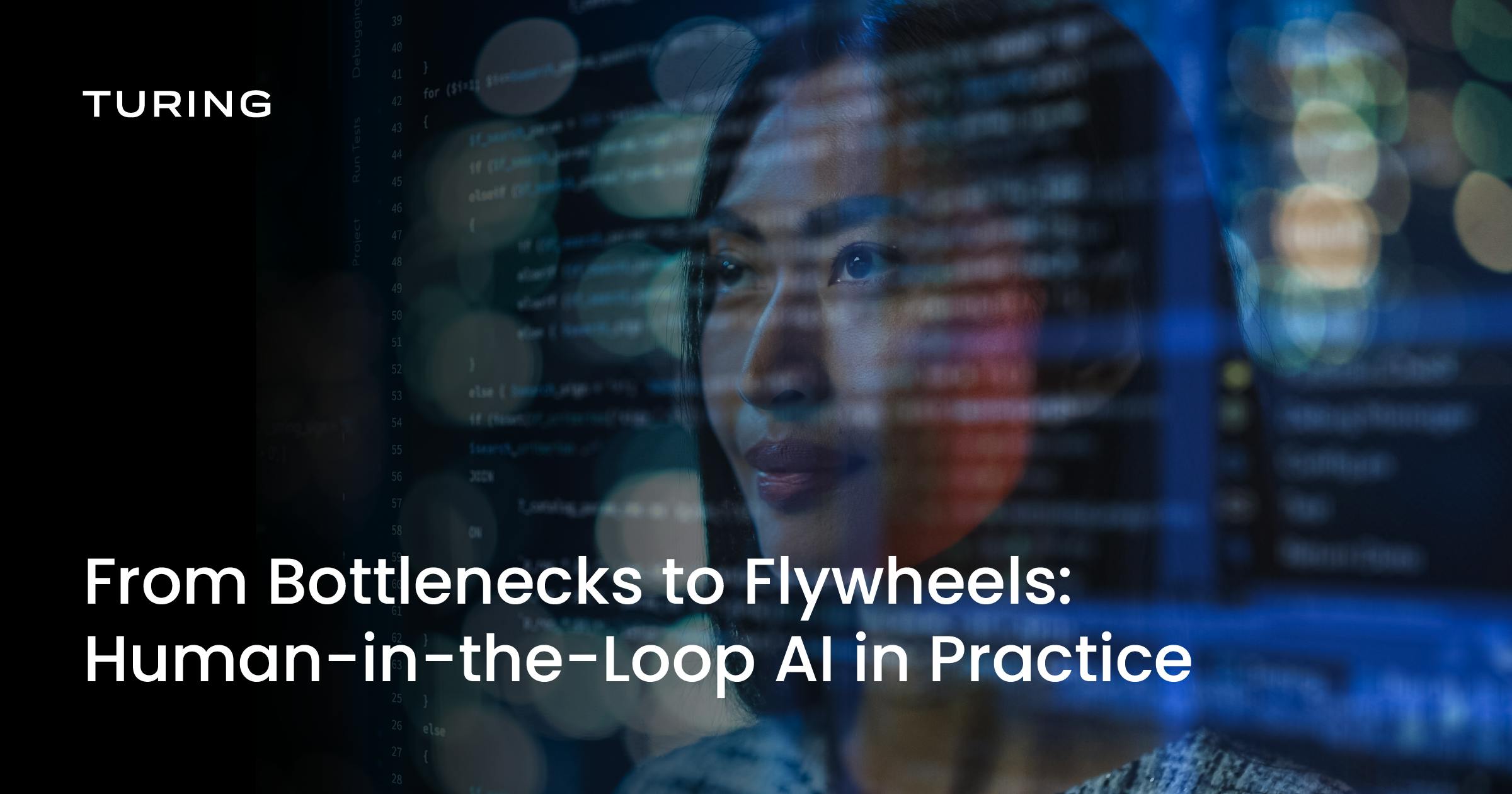From Bottlenecks to Flywheels: Human-in-the-Loop AI in Practice

Suresh Raghunath
•3 min read
- Hiring vetted talent
- Talent onboarding and operations

As businesses scale, manual human review processes often become bottlenecks because they’re costly, inconsistent, and difficult to monitor. Leaders recognize that machine learning (ML) can dramatically improve efficiency, but adopting ML systems also introduces important considerations around quality assurance, explainability, and deployment governance. This is especially true in use cases where decisions directly affect people, such as hiring, content moderation, or performance evaluation.
The solution isn’t to immediately replace humans, but to augment them. By building human-in-the-loop agentic systems, enterprises can gradually transfer low-risk decisions to ML while retaining expert oversight where it matters. This is not only a safe path to automation but a sustainable one.
The Core Philosophy: Augment, Don’t Replace
Traditional automation aims to eliminate humans from the loop entirely. But in processes that require judgment, nuance, or adaptation, like reviewing resumes, assessing code, or moderating content, full automation can lead to failure or mistrust.
Instead, a human-in-the-loop system is designed to:
- Prioritize confidence-aware automation (auto-pass or auto-reject where the model is highly certain)
- Route ambiguous cases to human reviewers
- Use feedback loops to refine the model and human process over time
This agentic approach means your ML systems are always improving, not just with more data, but with targeted supervision and correction.
How to Get Started: A Practical Playbook
Here’s how enterprise teams can apply this philosophy to any high-volume decision process:
1. Identify a Human Bottleneck
Choose a task that is:
- Repeatable and high-volume
- Currently performed by humans, experts, and non-experts
- Easily assessed, with well-defined rubrics for observable outcomes
2. Instrument the Workflow
- Collect inputs, human decisions, time taken, reviewer identity, and ground truth.
3. Introduce Model Predictions in Shadow Mode
- Run the ML model alongside humans without influencing decisions.
- Compare performance, understand failure modes, and identify thresholds.
4. Validate Against Expert Ground Truth
- Use expert-annotated samples to calibrate trust in ML models and improve the non-expert review process.
5. Deploy
- Classify ML predictions either as auto-reject, auto-pass, or “needs-human-review.
6. Monitor, Measure, Iterate
- Track model-human agreement, cost per decision, reviewer consistency, and throughput improvements.
- Repeat steps 4 and 5 to continually improve the model and the quality of human reviews.

Auto-Reviewing Developer Code Submissions
At Turing, we applied this strategy to improve how we assess developer submissions from coding challenges. Originally, each submission was reviewed by a human, often a non-expert, leading to variable quality and significant operational costs.
The Solution:
- Each submission (source code + metadata) is scored using both conventional signals (e.g. test case pass rate) and rubric-based large language model (LLM) judgements (e.g. code readability and maintainability).
- A gradient boosting model learns from past human-labeled decisions. The model outputs: auto-pass, auto-reject, or needs human review.
- Human reviewers provide final assessments for the submissions that are classified as “needs human review.”
- A sample of submissions are reviewed by experts, and this is used to improve/retrain the ML model as well as the human review process.
Performance Outcomes:
- 85% of all submissions are now confidently auto-assessed, either as auto-reject or auto-pass.
- In the auto-assessed zone, our model had 90% agreement with human experts.
- Cost per decision was reduced by 60%, as humans had to assess only 30% of the submissions.
Read the full case study here
What Leaders Should Know
1. Trust is Built with Transparency
- Expose teams to model outputs before letting them influence decisions.
2. Experts Are Not Optional
- They are critical for training, QA, and governance.
3. Disagreements Are Gold
- Model-human disagreement helps drive learning and refinement.
Final Advice: Move Fast, Stay Grounded
Enterprise AI initiatives often stall, aiming for full automation from day one. Instead:
- Start with instrumentation, not automation.
- Keep the human in the loop until models show readiness.
- Treat your ML model like a junior analyst: always learning, always accountable.
With this approach, you can turn bottlenecks into flywheels—and deploy ML systems that are not just powerful, but trusted.
Agentic systems offer a practical path to AI adoption, striking a balance between automation, oversight, and speed with safety. If you’re exploring how to reduce operational friction without compromising governance, we can help you design, scope, and deploy with clarity.
Talk to a Turing Strategist to define your next steps.
Want to accelerate your business with AI?
Talk to one of our solutions architects and get a complimentary GenAI advisory session.
Get StartedSuresh Raghunath is a Director of Data Science at Turing. He leads a global team of data scientists and ML engineers, focusing on advancing the training and deployment of Generative AI through human-in-the-loop systems, fine-tuning research, and data-driven experimentation. With over 20 years of experience spanning Fortune 500s and high-growth startups, Suresh has built and scaled AI teams that drive measurable business impact.
Share this post

Want to accelerate your business with AI?
Talk to one of our solutions architects and get a complimentary GenAI advisory session.
Get Started